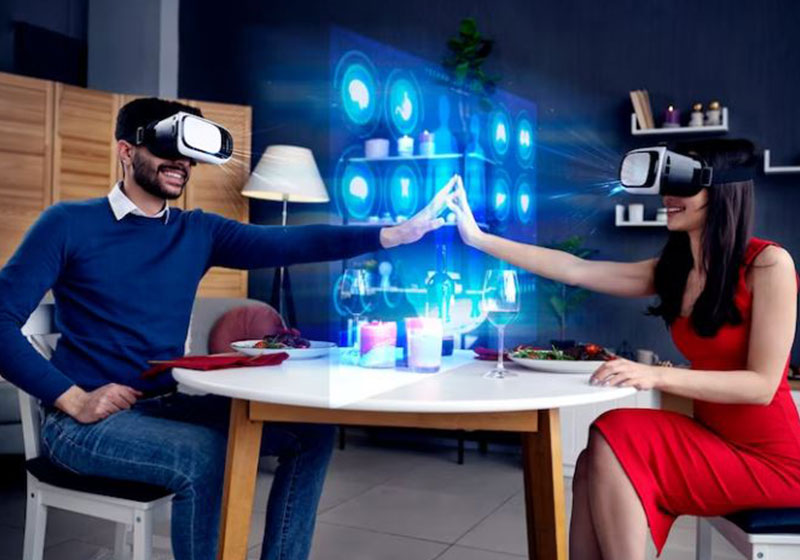Augmented Reality
Why Every SME Needs an Augmented Reality Strategy
 Updated 01 Nov 2023
Updated 01 Nov 2023

The volume of data produced in one day today is more than all the data ever collected before 2002. The disparity between the data available for use and its real-world applications is increasing. We live in a three-dimensional world, while the data we use to make informed decisions are generated in two dimensions, on screens and pages. The disconnect between the digital and the real world restricts us if we wish to use these large volumes of insights and data generated by the billions of smart devices around the world.
Augmented reality aims at reducing this disparity by releasing unique and untapped capabilities. AR combines several technologies that superimpose images and data into the real world. While the technology is still in the initial stages, it is set to become a mainstream technology. According to estimates shared by one report in 2020, industrial spends on AR have already crossed $60 billion. AR is going to impact businesses across all industries, along with several types of organizations like social corporations and universities. In the years and months to come, it is going to disrupt our learning methods, decision-making processes and interactivity with the world around us. AR is also going to transform the way businesses train employees, serve consumers, manage value chains and design and create new products. It will eventually determine which businesses have a competitive edge and which ones don’t.
What is Augmented Reality?
AR is a created interactive experience, where a computer-generated visual or data is used to enhance real-world objects or environments. In other words, AR is a bridge between virtual worlds and the real one.
AR & VR are Not the Same
Many managers and even business heads seem to use augmented reality and virtual reality interchangeably. But the two are fundamentally quite different. Virtual reality digitally reproduces a real-life situation. On the other hand, augmented reality adds several virtual elements to accentuate a real-world situation.
AR creates a better user experience by adding digital graphics or images to the world. Imagine any Instagram filter that adds a hat or even makeup to a person’s face when activated. In contrast, VR makes a reality of its own, controlled and generated by a computer. When it comes to the method of transmission, devices like remote controls or helmets are used to transmit the virtual experience to the audience. For AR experiences, all you need is a mobile device with a functional camera.
Why Does Your Business Need an Augmented Reality Strategy?
Any business that has adopted AR technology has seen strong and steady benefits. AR helps SMEs reach a whole new level of business growth and profitability. Here’s why your business needs an AR strategy too:
1. Avoid design errors
Developing new equipment is a complex process. Flaws that emerge at this point can cost a bomb and take too much time to eliminate. Using AR in your business helps save resources and money by working with a virtual prototype before creating the physical model. When you use a tablet, you can show experts your 3D models as a projected prototype. You can also arrange virtual design tests to find the flaws that might have been overlooked during the designing process.
2. Speed up the product installation process
Tech companies take a while to decipher any instructions given. SMEs are always looking for ways to speed up the installation of mechanisms and ensure the work quality guarantee. AR allows businesses to put in less effort and decrease the TTM (time to market). AR can completely replace physical paper printouts.
3. Maintenance and repair simplified
Any production needs timely repairs and consistent maintenance. Failure to do so could increase downtime and financial losses. AR technology is a business tool that can help solve these problems. It lets professionals see hidden building infrastructure within walls. Data about system health is transmitted using sensors, while interactive programs help locate the exact damaged spots.
4. Assured logistics savings
Warehouses contain hundreds or thousands of products. In such warehouses, cargo installation takes a lot of time. The human factor also makes an impact and increases the chances of human error. AR helps in optimizing logistic flows by reading unique codes and using their data to provide personnel with the necessary instructions.
5. Staff learns quicker and more efficiently
Everyone needs training from time to time, even the top professionals in a field. However, this training takes up valuable time that could be spent more productively. AR provides a more efficient learning method that allows faster learning and eliminates the human element. In such a situation, a notification program works better than personal mentors.
Industries That Benefit from AR Strategies:
Manufacturing
Manufacturing has always been a labor-intensive industry. AR helps to automate workflows and speed up the entire process. It allows engineers to work faster and not spend too much time learning how to perform tasks like assembly. They would usually have to spend years training to assemble products. However, AR glasses can help them view renders of instructions and instruments to construct any equipment or component much faster. Other benefits include easier data access, reduced maintenance time and costs, no more downtime and error minimization.
Retail
AR enables a closer connection between brands and customers. It begins by identifying the problem of the customer and then finding a product to solve it. In retail, AR helps businesses to improve sales and revenue and increase brand awareness. It also provides additional information to help the customer make a more informed buying decision.
Gaming and Entertainment
Gaming is constantly evolving and hitting new levels of sophistication. AR simulation games are globally recognized and widely loved by gamers and non-gamers alike. AR helps create a more realistic cabin experience and helps them experience the thrill of the video game world in a safe environment.
Healthcare
Augmented reality allows healthcare workers to monitor patients’ vitals and ensure the right treatment is given. AR-enabled applications notify doctors regarding any abnormalities, signs or symptoms so that they can assist the patient immediately.
Enterprises around the world are adopting an augmented reality strategy to boost business. This is the sign you’ve been waiting for to leverage AR for your business today.
Table of content
- – What is Augmented Reality?
- – AR & VR are Not the Same
- – Why Does Your Business Need an Augmented Reality Strategy?
- – Industries That Benefit from AR Strategies
Need to hire offshore developers?
Explore More

Mobile Applications

